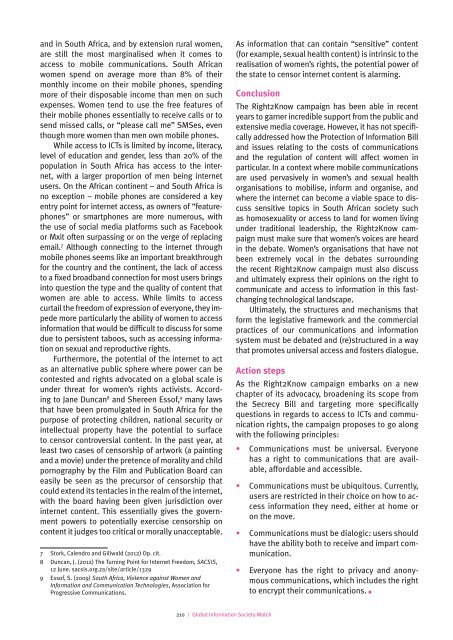gisw13_chapters
gisw13_chapters
gisw13_chapters
You also want an ePaper? Increase the reach of your titles
YUMPU automatically turns print PDFs into web optimized ePapers that Google loves.
and in South Africa, and by extension rural women,are still the most marginalised when it comes toaccess to mobile communications. South Africanwomen spend on average more than 8% of theirmonthly income on their mobile phones, spendingmore of their disposable income than men on suchexpenses. Women tend to use the free features oftheir mobile phones essentially to receive calls or tosend missed calls, or “please call me” SMSes, eventhough more women than men own mobile phones.While access to ICTs is limited by income, literacy,level of education and gender, less than 20% of thepopulation in South Africa has access to the internet,with a larger proportion of men being internetusers. On the African continent – and South Africa isno exception – mobile phones are considered a keyentry point for internet access, as owners of “featurephones”or smartphones are more numerous, withthe use of social media platforms such as Facebookor Mxit often surpassing or on the verge of replacingemail. 7 Although connecting to the internet throughmobile phones seems like an important breakthroughfor the country and the continent, the lack of accessto a fixed broadband connection for most users bringsinto question the type and the quality of content thatwomen are able to access. While limits to accesscurtail the freedom of expression of everyone, they impedemore particularly the ability of women to accessinformation that would be difficult to discuss for somedue to persistent taboos, such as accessing informationon sexual and reproductive rights.Furthermore, the potential of the internet to actas an alternative public sphere where power can becontested and rights advocated on a global scale isunder threat for women’s rights activists. Accordingto Jane Duncan 8 and Shereen Essof, 9 many lawsthat have been promulgated in South Africa for thepurpose of protecting children, national security orintellectual property have the potential to surfaceto censor controversial content. In the past year, atleast two cases of censorship of artwork (a paintingand a movie) under the pretence of morality and childpornography by the Film and Publication Board caneasily be seen as the precursor of censorship thatcould extend its tentacles in the realm of the internet,with the board having been given jurisdiction overinternet content. This essentially gives the governmentpowers to potentially exercise censorship oncontent it judges too critical or morally unacceptable.7 Stork, Calendro and Gillwald (2012) Op. cit.8 Duncan, J. (2012) The Turning Point for Internet Freedom, SACSIS,12 June. sacsis.org.za/site/article/13299 Essof, S. (2009) South Africa, Violence against Women andInformation and Communication Technologies, Association forProgressive Communications.As information that can contain “sensitive” content(for example, sexual health content) is intrinsic to therealisation of women’s rights, the potential power ofthe state to censor internet content is alarming.ConclusionThe Right2Know campaign has been able in recentyears to garner incredible support from the public andextensive media coverage. However, it has not specificallyaddressed how the Protection of Information Billand issues relating to the costs of communicationsand the regulation of content will affect women inparticular. In a context where mobile communicationsare used pervasively in women’s and sexual healthorganisations to mobilise, inform and organise, andwhere the internet can become a viable space to discusssensitive topics in South African society suchas homosexuality or access to land for women livingunder traditional leadership, the Right2Know campaignmust make sure that women’s voices are heardin the debate. Women’s organisations that have notbeen extremely vocal in the debates surroundingthe recent Right2Know campaign must also discussand ultimately express their opinions on the right tocommunicate and access to information in this fastchangingtechnological landscape.Ultimately, the structures and mechanisms thatform the legislative framework and the commercialpractices of our communications and informationsystem must be debated and (re)structured in a waythat promotes universal access and fosters dialogue.Action stepsAs the Right2Know campaign embarks on a newchapter of its advocacy, broadening its scope fromthe Secrecy Bill and targeting more specificallyquestions in regards to access to ICTs and communicationrights, the campaign proposes to go alongwith the following principles:• Communications must be universal. Everyonehas a right to communications that are available,affordable and accessible.• Communications must be ubiquitous. Currently,users are restricted in their choice on how to accessinformation they need, either at home oron the move.• Communications must be dialogic: users shouldhave the ability both to receive and impart communication.• Everyone has the right to privacy and anonymouscommunications, which includes the rightto encrypt their communications. ■210 / Global Information Society Watch


